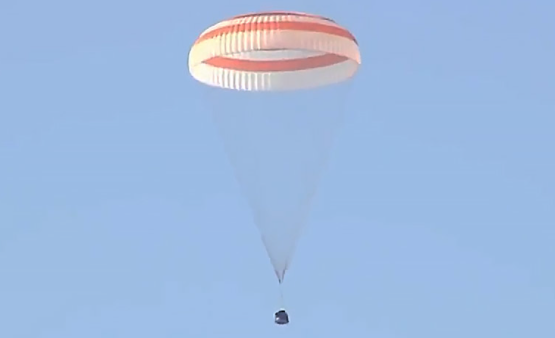
HOUSTON—Russia’s Soyuz MS-19 descended under parachute to a safe landing in remote Kazakhstan after departing the International Space Station (ISS) early March 30 with two cosmonauts and NASA astronaut Mark Vande Hei, whose stay set a new record of 355 days for the longest U.S. human spaceflight.
The space capsule with commander Anton Shkaplerov, cosmonaut Pyotr Dubrov and Vande Hei was greeted by helicopter-borne Russian and U.S. recovery forces within moments of touching down southeast of Dzhezkazgan at 7:28 a.m. EDT, or 5:28 p.m. local time. After medical checks at the landing site, Vande Hei and his Russian colleagues were to be flown by helicopter to Karaganda, Kazakhstan, where Vande Hei was to board a NASA jet to be flown to NASA’s Johnson Space Center in Houston, where he trains and lives.
Dubrov, who also logged 355 days living and working aboard the ISS, and Shkaplerov, who logged 176 days, were to be flown to Russia’s Star City, home to the cosmonaut training center.
Vande Hei was grinning and waving as he was helped from the Soyuz capsule 28 min. after the landing and following the extraction of the two cosmonauts. His 355-day spaceflight tops the previous U.S. spaceflight record of 340 days set by retired NASA astronaut Scott Kelly over 2015-16.
Nine NASA astronauts have now flown missions longer than 200 days in space. Made possible by the ISS, those long missions, which include Christina Koch’s 328 days and Peggy Whitson’s 289 days, are providing medical data intended to help enable future missions of human deep-space exploration. Missions to Mars using current propulsion technologies could span two to three years.
In each case, the health of NASA’s long-duration ISS astronauts is evaluated before, during and long after they return to Earth.
The world’s record for the longest human spaceflight, 438 days, was set by cosmonaut Valeri Polyakov aboard Russia’s former Mir space station over 1994-95.
Despite global tensions over Russia’s invasion of Ukraine, the MS-19 crew and the recovery squads appeared to perform as a team during the return to Earth, which included an ISS fly-around that afforded Dubrov an opportunity to image close up the Nauka Multipurpose Laboratory module, launched in July 2021, and the Prichal docking compartment that arrived at the station in November 2021.
NASA provided live television and streaming imagery of the departure and landing activities, as well as commentary from the agency’s Mission Control Center.
The MS-19 trio were warmly embraced by their ISS colleagues as they prepared to enter their Soyuz spacecraft for undocking at 3:31 a.m. EDT. As MS-19 undocked from the Rassvet module, command of the ISS transitioned from Shkaplerov to NASA astronaut Tom Marshburn, who leads ISS Expedition 67.
After maneuvering away from the ISS, the Soyuz capsule carried out a 5 min., 39 sec. deorbit burn at 6:34 a.m. EDT.
“We are feeling great,” Shkaplerov radioed flight control teams in Moscow during the final moments of the descent.
Prior to the undocking, Vande Hei spoke of the challenges he confronted during his long separation from Earth, family and friends. At mealtimes, the ISS multinational crews regularly do more than dine, he noted. They discuss their activities and joke. Vande Hei also meditated regularly and made it a point each day to mentally focus on the scientific research and maintenance activities assigned to him each day.
The retired U.S. Army colonel and physicist said he looked forward upon his return to Earth to talking and sharing a cup of coffee with his wife, Julie. The couple has two children, his biography says.
The spaceflight was Vande Hei’s second to the ISS. He has logged a total of 523 days in space, the third highest among U.S. astronauts.
The spaceflight was Shkaplerov’s fourth, and he has now logged a total of 708 days in space. The 355-day flight was Dubrov’s first.
Vande Hei and Dubrov launched on April 9, 2021, aboard the Soyuz MS-18 from the Baikonur Cosmodrome in Kazakhstan with their commander, cosmonaut Oleg Novitskiy.
The ISS is currently undergoing a multiweek crew exchange. Replacements for Vande Hei, Dubrov and Shkaplerov arrived aboard the Soyuz MS-21 on March 18. They are cosmonauts Oleg Artemyev, Denis Matveev and Sergey Korsakov.
In addition to Marshburn and the MS-21 trio, the ISS is currently staffed by NASA’s Raja Chari, Kayla Barron and the European Space Agency’s (ESA) Matthias Maurer.
As part of the exchange, they are to be joined by NASA astronauts Kjell Lindgren, Bob Hines and Jessica Watkins as well as ESA’s Samantha Cristoforetti following the launch of the SpaceX Crew-4 Dragon from NASA’s Kennedy Space Center on April 19.
The actual launch and docking dates of the Crew-4 Dragon will determine when the SpaceX Crew-3 Dragon departs for Earth with Marshburn, Chari, Barron and Maurer for a parachute-assisted splashdown in the ocean waters off the Florida coast. The current plan for their return is late April.





